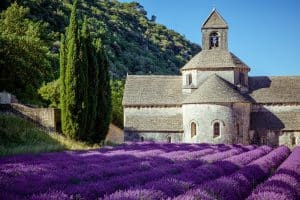A Guide To Provence, The Luberon

Written exclusively for Expat Network by Annie Button
You may have spent the day exploring the region’s perched villages, such as Gordes or Bonnieux. Or you’ve chosen a more adventurous trail and have explored the Luberon’s beautiful nature with hiking trails and river beaches galore. Or maybe you’ve been to the market, antique hunting in L’Isle-sur-la-Sorgue.
Or maybe, it doesn’t even matter what you did. You’ve got a boot full of fresh vegetables from the market and you’re frantically discussing what culinary Provençal masterpiece you’ll be preparing this evening.
Now open your eyes. Boom, back to reality. But it doesn’t have to remain a daydream, the South of France is nearby, and the region is surrounded by dozens of travel hubs. It’s affordable, certainly compared to the dazzle of the French Riviera, and it’s compact and unspoilt.
Getting Around
Granted, the region is not as easy to reach than the coastline of the Cote d’Azur or Languedoc; but this only adds to its character and sense of serenity. Marseille is one of the biggest international airports in the South of France and has the Luberon on its doorstep. If you’d rather stay with both feet on the ground, then the train could be a very interesting option. Gare d’Avignon is one of the region’s most important TGV station with direct lines from the UK, Germany and the Netherlands. Of course, the region is also just off the Route de Soleil ensuring easy access by car.
Nature Park
At the core, the Luberon remains a nature park. It’s got a distinct Provençal character with a patchwork of lavender fields and vineyards making out the valleys between the three main mountain ranges. It offers countless possibilities to be in nature. Hiking trails criss-cross the hills, the valleys make great grounds for cycling and the lakes and rivers provide a great base to cool down amidst it all. It’s simply revitalising to get lost in this slow-paced limbo of greens and pastels.
History
The region has also got a rich history which is tangible in the famous ‘villages perchées’, or perched villages. These hilltop villages are 1000s of years old and make excellent excursions for young and old. Gordes is without a doubt the most well known of these villages perchées, and for good reason. As you walk into this village a sense of calm descends on you, life ticks to a different clock here. It’s also quite simply a terribly good-looking village, with insta-perfect snaps around every corner. The nearby Senanque Abbey must be one of the most photographed abbeys of the area and the open-air museum – Village des Bories – is also worth a visit. The village of Bonnieux, Lacoste and Lourmarin are also not to be missed!
Markets
Another thing you think of when you hear the Luberon, are markets. And there are lots of them! And they sell nearly anything. L’Ilse-sur-la-Sorgue, although not on a hilltop but rather on a fork of the Sorgue river, is one of the most popular towns in the area. It’s a pretty picturesque town dubbed the Venice of Provence due to its many canals and creeks. It boasts brilliant markets and is considered the antiquing centre of the Provence. The riverside is lined with bars and restaurants, brilliant for a coffee or a drawn-out lunch.
Avignon
Avignon is also not to be missed. It’s got so much more to offer than just its famous Pont d’Avignon. In the 14th century, this city quickly grew to be one of the most important cities of Europe. This was all due to the Papal Seat moving here the century prior, resulting in the construction of the immense Gothic masterpiece that is the Palais des Papes. It housed the largest library of Europe and made the city a focal point for study and religion attracting scholars from all over the continent. The city itself is also a pleasure to stroll through, with a pretty historic centre and squares lined with bars and restaurants. You can also follow the defensive wall around the city, which makes for an interesting walk.
Gorges du Verdon
At the other end of the Luberon are the Gorges du Verdon, a natural beauty carved out of the rocks by the Verdon river. This 700-meter-deep canyon is considered to be Europe’s most beautiful canyon, and for good reason. It’s brilliant for a road trip and considered a hiker’s and climber’s Walhalla. Another popular way to see the ravine is by descending the river itself by kayak. During summer the river is nothing more than a mellow stream snaking the cliffs, offering a refreshing break from the hot mid-day sun.
From nature and adventure to history and culture. With excellent cuisine and laid-back vibe. The Luberon has it all.